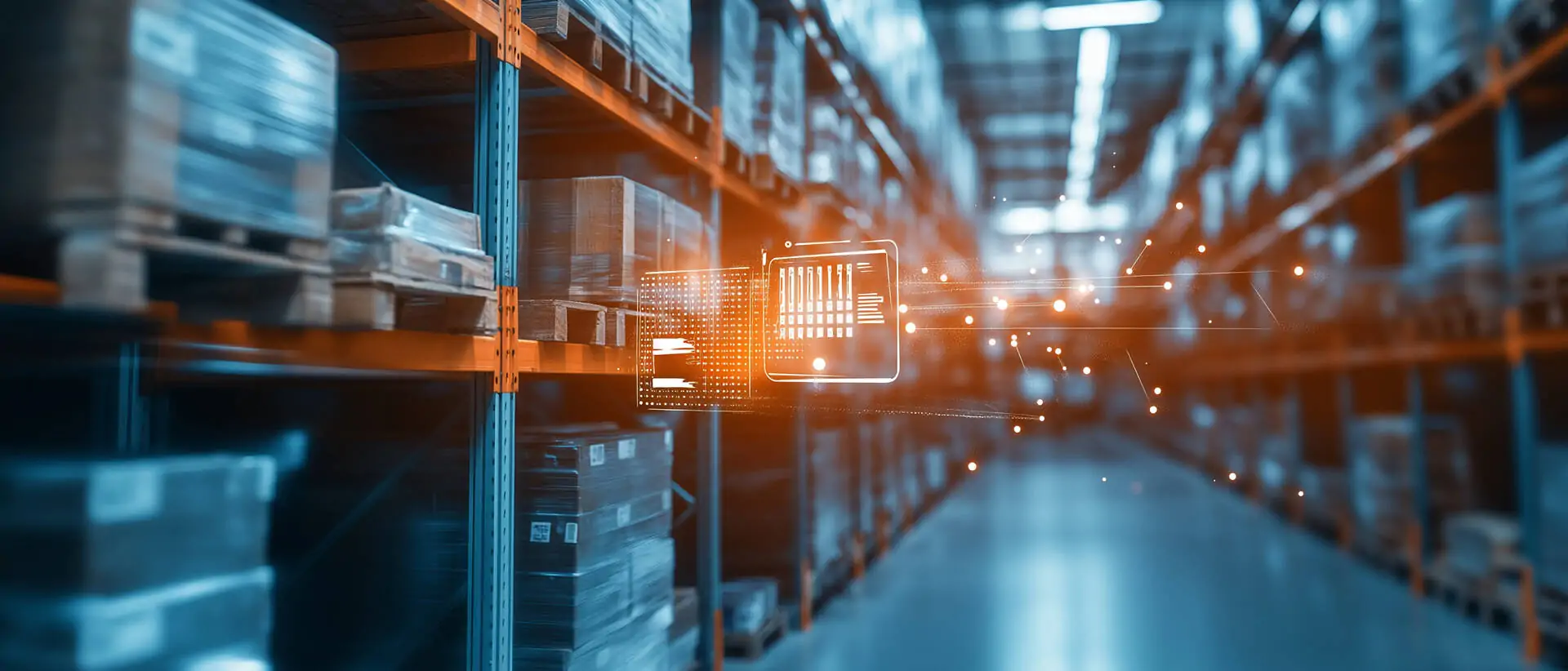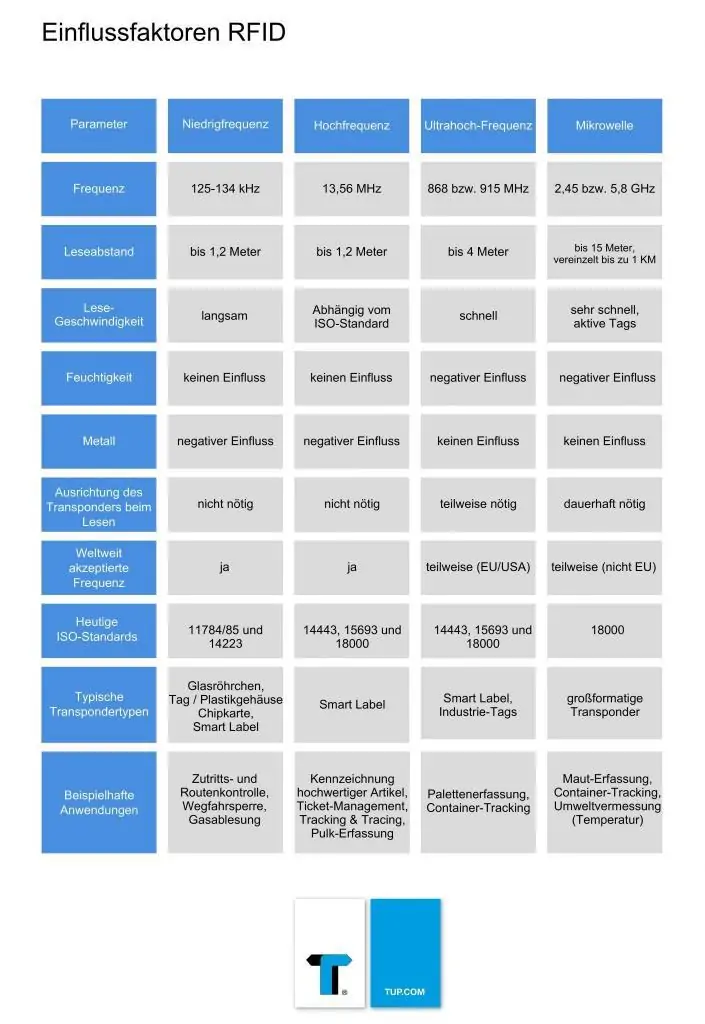Radio Frequency Identification (RFID) is a technology for the unique and contactless identification of objects (goods, living beings, even conditions) of all kinds. With the help of transmitter and receiver units, it enables fast and automatic data collection using electromagnetic waves. The technology opens up new practical areas of application in the fields of logistics, intralogistics, materials management (see inventory management), industrial machines, service and identification. If sufficient information is available in the memory, this is also referred to as unambiguous identification.
Radio Frequency Identification is increasingly replacing the well-known properties of barcodes (see Advantages and disadvantages of barcodes and RFID) or the optical recognition of objects. Contactless technology is used as a generic term for the entire technical infrastructure and includes the following elements:
- the transponder (also known as a label, chip or tag)
- the (transmitter) receiver unit (also called reader)
- integration with servers, services and other systems such as cash register systems (see also POS system), merchandise management systems or forklift control or driverless transport systems
RFID – the history
The first commercial forerunners of RFID technology were launched on the market in the 1960s. These were electronic article surveillance (EAS) systems to prevent theft. At that time, it was only possible to transmit one bit of information. This meant that only the presence or absence of the marking could be checked. The systems were also based on microwave technology or induction. It was not until the 1970s that numerous new developments were made to facilitate the use of RFID technology in various areas. Work focused primarily on the identification of animals, use in automation and the automatic identification of vehicles in traffic. The technology was particularly promoted in the 1980s by the decision of several American states and Norway to use RFID transponders in road traffic for toll systems. In the 1990s, the technology continued to gain acceptance for toll systems; new areas of application were also opened up by developing systems for access control, cashless payment, ski passes and fuel cards.
The turn of the millennium brought with it a sharp drop in the price of the technology due to mass production, which also made it possible to use transponders in consumer goods. However, the technology had developed so rapidly that it ultimately failed to define industry standards. Currently, various institutions and interest groups are increasingly working on extensions, standardization and standards for the technology.
RFID – the technology
There are various transponders, some of which differ greatly from one another. The basic structure of an RFID transponder consists of an antenna, an analog circuit for receiving and, if necessary, transmitting, a digital circuit and a permanent memory. RFID transponders can have a rewritable memory on which information can be stored during their service life.
The specifications of the respective chip also differ depending on the area of application:
- Radio frequency
- transmission rate
- Lifetime
- Cost per unit
- Memory capacity
- Range of functions
For special applications, cryptography modules or external sensors such as GPS and temperature gauges can also be integrated into the RFID transponder (see also environmental measurement). RFID technology is also used in personnel locks. In intralogistics, the tags are primarily used as a guidance unit for a forklift control system or automated guided vehicle system. The transponders are embedded in the floor for specific routes. Another standard feature is bulk detection, in which several tags/items are identified in parallel.
Radio Frequency Identification – the systems
RFID systems are basically related to chip cards. As with chip cards, the data is stored on an electronic data carrier. In contrast to chip cards, the data carrier is powered and data is exchanged between the data carrier and the reader by magnetic or electromagnetic fields – not by means of a contact field.
Radio Frequency Identification usually contains two basic components:
1. a transponder that is attached to the object to be identified.
2. a reader that can read and, if necessary, write to the transponder.
The transponder
A transponder is a basic component of an RFID system. It usually consists of the following components:
- Memory
- Coupling element, for example a coil or an antenna
- Electronic microchip
The following data is stored on the transponder:
- A unique identifier, for example the serial number of the microchip
- If applicable, information (producer or article number)
The advantages of RFID technology are that data can be overwritten and existing information can be added. In addition, sensors can be integrated into RFID transponders; so-called RFID sensor transponders. Decisive factors for the size of an RFID transponder are certain requirements for the antenna, the transmission power and the housing. The shape and size of the antenna is determined by the frequency or wavelength.
The reader
The reader of such a system consists of a reading or writing unit and an antenna. By sending electromagnetic waves, an electromagnetic energy field is generated and communication between the reader and transponder is realized by radio waves. During communication, the transponder is only active as soon as it enters the reception range of the reader, whereby the actual activation is carried out by a coupling unit – similar to the handshake procedure within a modem.
Transponders: passive and active
Passive RFID transponders
They obtain their energy for transmitting information inductively from the received radio waves. The amount of data stored is considerably less than with active RFID transponders. A unique identification number (GUID = Globally Unique Identifier) is usually stored in their memory. Some passive transponders are equipped with a rewritable memory.
Compared to active RFID transponders, passive RFID transponders are smaller and lighter, have a short range, an almost unlimited service life and are comparatively inexpensive.
Features of a passive transponder at a glance:
- Inductive energy supply from the received radio waves
- Transponders can only be read
- Low storage capacity
- Memory for unique identification number GUID = Globally Unique Identifier
- Smaller and lighter than active RFID transponders
- Short transmission range
- Almost unlimited service life
- Inexpensive
Example of a passive transponder: Smart Label:
Passive RFID transponders include smart labels, for example, which have a very thin form factor and are applied to a film. In this way, they can be used in a similar way to an adhesive label and stuck directly onto products. Communication takes place via inductive coupling with the reader, whereby a frequency of 13.56 MHz is usually used. The transmitter is supplied with power inductively via the reader.
Smart labels can be divided into three categories: Read-Only transponders, Write-Once/Read Many and Read and Write.
Read-only transponders
Read-only transponders can only be fitted with information once, usually by the manufacturer. It is not possible to overwrite the data afterwards. Their service life is usually short and process-oriented.
Write-Once/Read Many (WORM)
WORM transponders can only be written to once by the customer. Once information has been saved, the data can only be read out; however, the data may be read out several times.
Read and Write
Read and write transponders allow unlimited writing and changes to the memory content. Many read and write transponders also have write protection so that the stored information is protected against deletion or overwriting if necessary.
Active RFID transponders
They have their own power supply and can typically be both read and written to.
Active RFID transponders are normally in idle mode, i.e. they do not transmit any information. The transmitter is only activated when a special activation signal is received. Depending on the model, the internal memory can hold up to one million bytes. Compared to passive RFID transponders, active transponders are usually larger, have a greater transmission range, have a shorter service life and are significantly more expensive.
Features of an active transponder at a glance:
- Battery-operated
- Transponders can be both read and written to
- Do not transmit any information when idle – transmitter activates when a signal is received
- Depending on the model, the memory can hold up to one million bytes
- Relatively large
- Long transmitter range
- Shorter service life
- Significantly more expensive
Special case: semi-passive RFID transponders
In contrast to passive transponders, semi-passive transponders have their own power supply, for example in the form of a battery or solar cell.
This energy only serves as a power supply for the RFID chip, not for data transmission. Like passive transponders, semi-passive transponders obtain the energy and transmission frequency required for data transmission via the radio waves of the reader. As the reader’s field is no longer required to supply the RFID chip with energy, a weaker field can be used than for operating a passive transponder. This can lead to a significant increase in the communication range if it is possible for the transponder to receive the corresponding signals.
Transponders using polymer printing
Polymer printing or alternative printing processes can now be used to produce flexible and cost-effective (price is less than one cent per piece) RFID transponders – even outside of industrial environments. In addition, there are already examples of RFID technology being used directly in disposable products. This eliminates the need to manufacture RFID tags.
Frequencies and influencing factors
Communication problems
The large number of different devices and tags are rarely fully compatible with each other. The frequencies used and preferred standards vary greatly from region to region. Communication problems can also occur with products with a high water content (yoghurt, mineral water) and when used on objects with metal parts (shopping carts, car parts, conveyor belts). These can further reduce the already weak radiation of passive RFID transponders, for example. A similar impairment can occur if the RFID transponder is attached directly to products with a high density.
Summary of RFID
RFID (Radio Frequency Identification) refers to both the corresponding technology and the technical infrastructure that enables fast, automatic data capture via electromagnetic waves. This allows goods, living beings and conditions to be clearly identified without contact. Consisting of transmitter and receiver units, the systems differ in terms of their design, functions and properties. The aim is to establish international standards, such as those found in EPAL load carriers.
Teaser image: Maschinenjunge / CC BY-SA 3.0

